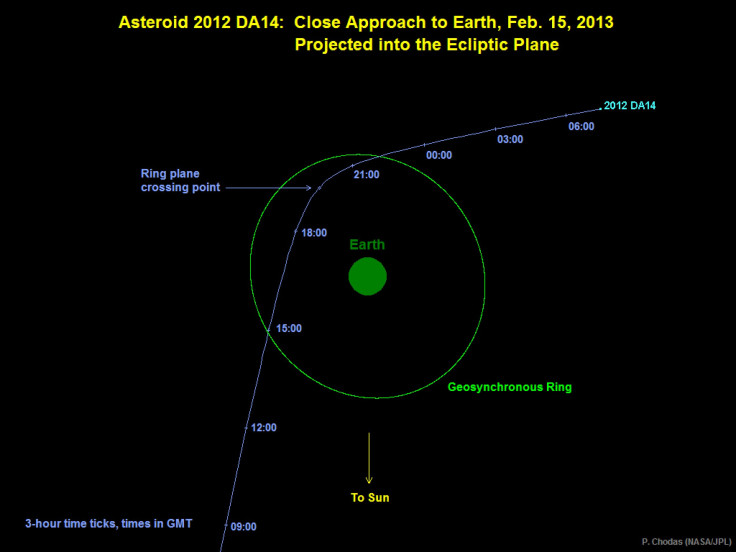Asteroid Flyby Day After Valentine's Day Could Be Record Breaking, Watch Asteroid's Trajectory [VIDEO]

A very large asteroid is set to flyby Earth on Feb. 15, one day after Valentine's Day. The asteroid will not hit Earth but will pass by incredibly close and could be a record for an asteroid of this size, NASA reported.
The asteroid was first discovered in February 2012 by the La Sagra Sky Survey from the Astronomical Observatory of Mallorca in Spain. NASA has been keeping track of asteroid 2012 DA14, and the asteroid is projected to pass close enough "that it will pass inside the ring of geosynchronous weather and communications satellites," NASA reported. Because of their great technology at hand, NASA can easily project the asteroid's flyby trajectory, and there is zero chance of any possible collision with Earth. While there is no threat to humanity's survival, the asteroid flyby will give researchers a unique opportunity to observe a rather large asteroid close up.
The asteroid is 150 feet in diameter, according to NASA, and will be at its closest point near Earth around 2:24 p.m. EST Feb. 15. At that time, the asteroid's path is projected to be over the Indian Ocean, notes NASA. The asteroid will be as close as 17,200 miles from Earth. While that may not seem close at all, satellites that orbit Earth are located 22,000 miles out from Earth's surface. The asteroid flyby is unique because of the close proximity, and, while the asteroid usually passes near Earth, it won't be as close to the planet for another 30 years.
“The 2013 flyby is by far the closest the asteroid will approach our planet for many decades," NASA said. "The next notable close approach to Earth will be on Feb. 16, 2046, when the asteroid will pass no closer than 620,000 miles from the center-point of Earth."
The asteroid will spend approximately 33 hours around Earth and the moon, weighs 130,000 metric tons and will be traveling at 17,450 miles per hours -- that's 4.8 miles per second, according to NASA. The asteroid is rare, according to NASA -- just 500,000 near-Earth asteroids are of similar size, and less than 1 percent of those have been discovered.
The record-breaking asteroid flyby will be closely watched by NASA, and a video the asteroid's projected trajectory can be viewed below.
© Copyright IBTimes 2024. All rights reserved.






















